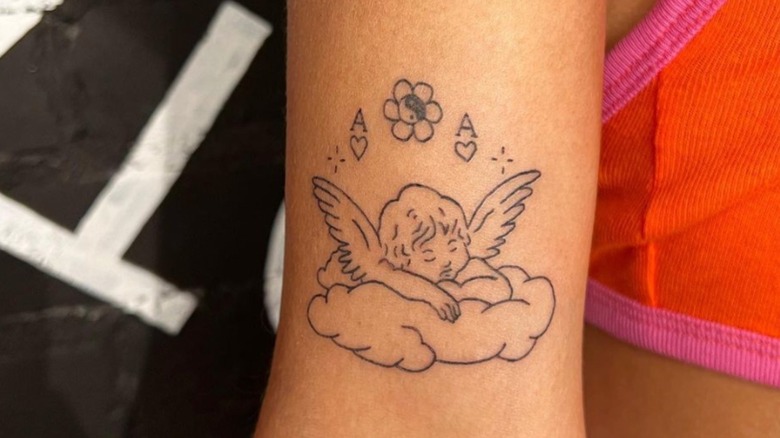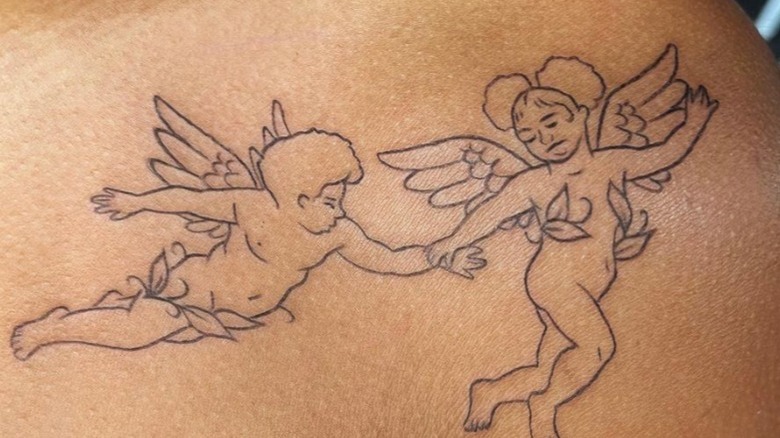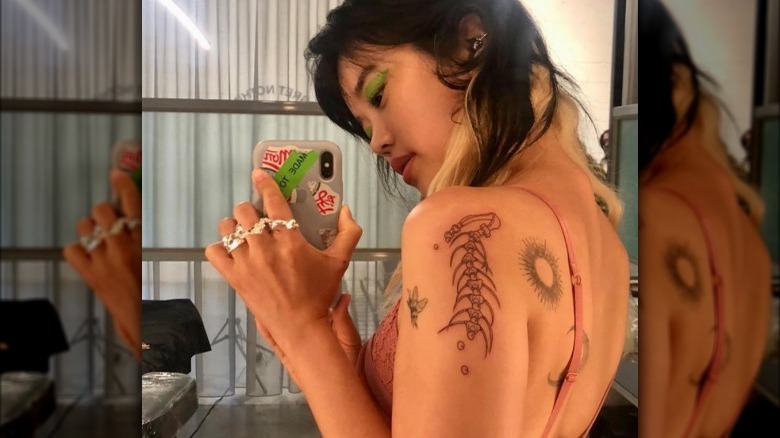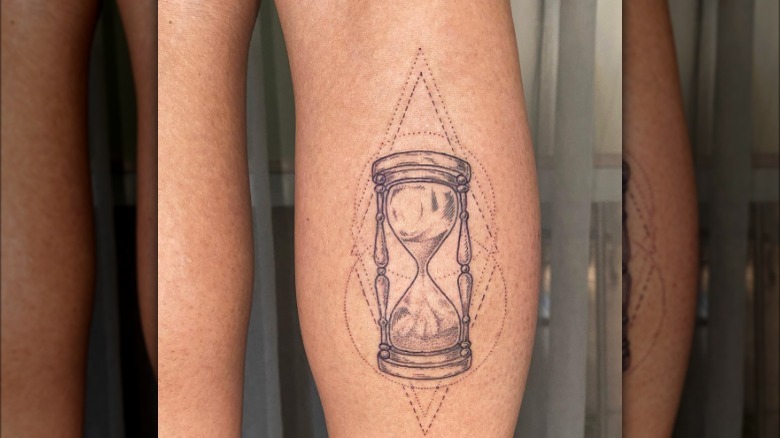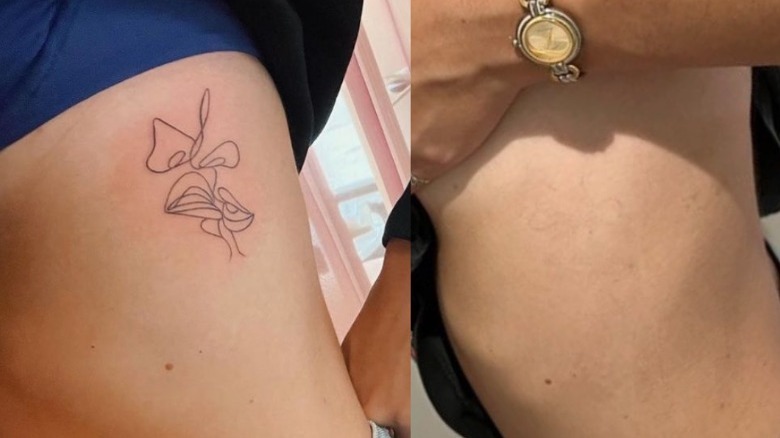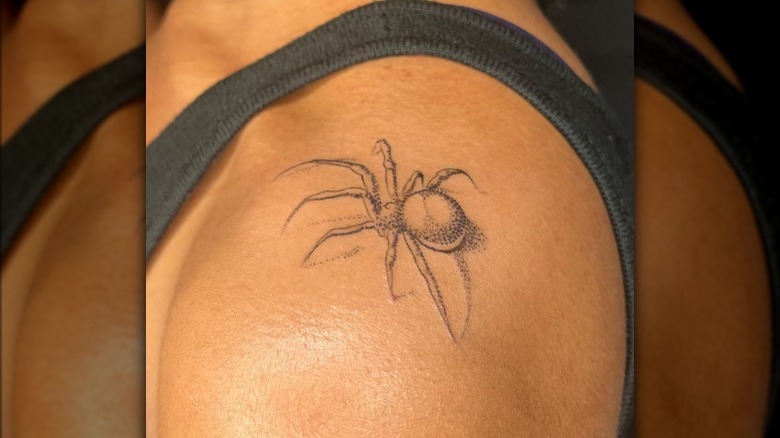Ephemeral Tattoos: Dip Your Toes Into The World Of Ink Without The Commitment
Do you want a tattoo but you're afraid of the permanence? Have we got great news for you! The new trend of ephemeral tattoos is taking away the intense pressure of asking yourself, "Will I still like this in ten years' time?" The new technology behind ephemeral tattoos means that experimentation is possible; there's the opportunity to give a permanent tattoo a trial run, or simply the chance to enjoy some body art that suits your aesthetic for the moment without the pressure of a life-long commitment.
Ephemeral tattoos took off in Brooklyn, New York, but have since expanded locations all over the United States. The tattoo itself is expected to last anywhere from 9-15 months, depending on a person's particular skin composition. So how does this new tattoo process work? Jeffrey Liu, CEO of Ephemeral Tattoo, told PopSugar that the ink is "made from medical-grade, bioabsorbable, and biocompatible polymers with high-quality pigments routinely used in foods, cosmetics, and other products," so the ink shrinks in the body and fades away. All products in the ink are FDA approved. Like permanent tattoos, ephemeral tattoos are applied using a needle handled by a trained tattoo artist, so the process itself is similar. Of course, permanent tattoos fade over time too, but ephemeral tattoos are meant to disappear eventually without a trace. However, there are a few things to know about ephemeral tattoos before diving in.
How much do ephemeral tattoos cost compared to permanent ones?
Like with traditional permanent ink, the cost of an ephemeral tattoo depends upon the design itself. Typically, they range anywhere from $250-$450 dollars. Ephemeral Tattoo's co-founder Josh Sakhai explained to Dazed Beauty that part of what goes into the cost is the experience itself — the knowledge that you're free of a lifetime commitment to a design and the cost of tattoo removal in the future, should you have any regrets. "The fact that it's made-to-fade is an added benefit, not a detractor from the price."
For reference, permanent tattoos have a huge range in cost, again depending on what a client is looking for; however small, permanent tattoos cost around $50-$100 and go up to several thousand dollars for large designs. This marks a notable shift between permanent tattoos and ephemeral ones; ephemeral tattoos are "roughly three times the market rate" of permanent tattoos, Fast Company notes. A small ephemeral tattoo comes to approximately $175, compared to the $50-$100 of its permanent counterpart. But the boutique aspect of ephemeral tattoos is part of the reason for their price; they're typically at least double the cost of a permanent one, but this is partially because they're only available at a few, select locations. Plus, the appeal is that they aren't forever, saving the cost of regret. Even impermanence has a price.
What to expect during a session
Particularly for those uninitiated in the world of tattoos, the experience of getting an ephemeral tattoo can be great because it's very similar to that of a permanent one. The tattoo artist goes over the design with the client, carefully picks out the best location, and gets to work. Josh Sakhai told Dazed Beauty: "You're set up in a private tattoo booth with a tattoo artist who will do a consultation with you, talk through your design and any concerns you have," he said.
One difference that people notice is that tattoo artists are careful with shading or any other design that requires a lot of work on the skin, since the tattoo is meant to be temporary and the artist doesn't want to work too heavily with the ink. In fact, ephemeral tattoos turn out the best if the design is mostly linear without too much shading. In fact, if any shading is done, it's completed through dots or crosshatch pattern. On top of that, the tattoos are only available in black ink as of now; colored ink is still in development.
What about pain? One writer reported on PopSugar that her experience was more painful than getting a permanent tattoo because the artist had to work more slowly and press the needle in deeper. However, another writer who got an ephemeral tattoo reported to Men's Health that the experience was no more painful than a permanent one and suggested taking an ibuprofen an hour before an appointment.
Your aftercare
In the good old days, it was typical to see a freshly completed permanent tattoo wrapped in saran wrap, but for ephemeral tattoos (and even for many permanent tattoos now), this practice is passé. After an ephemeral tattoo is completed, the tattoo artist wraps the finished design in hydrocolloid, a moisture-absorbing dressing that's also used to make pimple patches. The purpose of the hydrocolloid is to draw out any liquid during the healing process; think fun stuff like body fluid or excess ink. The patch should remain on the tattoo for 2-4 days.
One writer who got an ephemeral tattoo wrote for PopSugar that the healing process was a little slower than a permanent one. The flaky stage lasted for roughly a week while the final healing took between four to six weeks. But no one is on their own during recovery time. Co-founder Josh Sakhai told Dazed Beauty, "At the end, we send you on your way with an aftercare goodie bag of top-of-the-line aftercare materials. And after that, it's not goodbye forever. We keep in really close contact with our clients to make sure they're having great healing outcomes, to check on any questions or concerns they have over time, and of course to welcome them back to get their next Ephemeral." Clearly, one is never enough.
The fading process
The fading process of an ephemeral tattoo is different for everyone. One client who shared her experience with PopSugar said that after six months, her tattoo had faded considerably; interestingly, she was also happy to see her tattoo go. The design she had chosen didn't end up being something she wanted to keep on her body forever, and so it was a relief to watch it slowly disappear.
Ephemeral Tattoo notes on their website that as the fading process begins, the ink saturation will slowly change from black to light gray. There are other factors that impact how quickly an ephemeral tattoo will fade; if the design is largely composed of thin lines and minimal shading, then it'll fade faster than other designs. It's also important to note that ephemeral tattoos on skin with more melanin appear to fade more rapidly than skin with less, simply because the ink is placed below the skin's pigment. In the end, though, each person's ephemeral tattoo will fade differently, largely because of how each unique immune system breaks down the biodegradable ink.
Warnings
Not all people are having the same experience with ephemeral tattoos and in some cases, the tattoos are lasting longer than anticipated. In fact, some clients reported to the San Francisco Chronicle that they felt regret over getting the tat after noticing the ink still hadn't faded well beyond the 15-month mark. One reader told the outlet, "If I had known I would still have this on my leg, I wouldn't have done it in the first place."
Another person jumped on Reddit to warn others that their ephemeral tattoo had not faded as promised. "My friends and I got ephemeral tattoos last year. It has been 13-15+ months for each of us. They look about the same as they did on month 2-3," the user wrote. Soon, other users chimed in with their testimonial, offering similar stories. "I expected it to fade more than it has. April 13 marks a year and while the fading is spotty, it's still pretty legible. Part of me is genuinely concerned it will not fade," they wrote. In the comments section, the client later gave an update that their tattoo had since considerably faded, but that the fading process was a little unattractive. "Right now it looks like a 20-year-old tattoo," they wrote. That's not all, though. Even though they're temporary, the tattoos still traumatize the skin and, in some cases, can leave scarring, even after they've faded.
